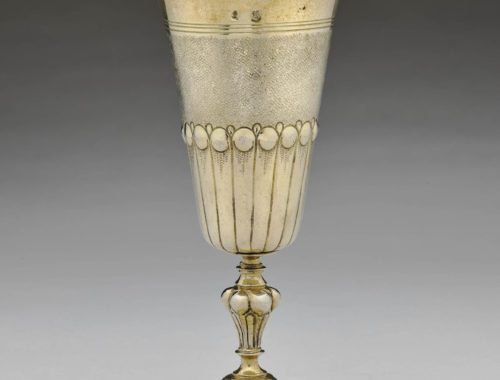Detailed Information
Fine Silver-Gilt Seventeenth Century German Cup
The cup has been developed as a drinking vessel since the sixteenth century. Its form takes direct inspiration from the churchly chalice or the ciborium. The present cup, silver, shows a very interesting, early type of drinking vessel, which is held in a very good condition. It has a beautiful, slightly conical form and it is very delicately decorated. The foot is somehow vaulted, profiled and is on its upper side bell shaped. It is very finely decorated, with punched and smooth areas. The shaft is raised above the foot in a very elegant way; it has a square form and on its upper side is with small humps adorned. The conical cuppa is raised above the shaft and is very fine finished: the lower half of it is adorned with fine gadroons, while in the middle, it is decorated with a frieze of small humps, the upper part is finely punched with the décor of snake-skin. Three rings separate the body from the rim of the cup. Inside and outside is gilt.
Historical and Art Historical Context
Drinking alcohol was not any longer negatively judged since the sixteenth century. On the contrary, excessively drinking was to be considered an achievement. The noble showed as a matter of fact in this way his strengths. Women besides did not fall short. During the seventeenth century, it happened often that there were fixed drinking habits at the table for members of the high society.
The existent variety of drinking vessels implies also that alcohol (mostly wine and beer) was quite central at the table. The cup takes in the sixteenth and seventeenth century many different forms. The height of the cup was in any case a feature that functioned as a status symbol for the one who was drinking out of it.
For a similar type of conical cup from the Southern German Area see the collections of the National Museum in Zurich.
Maker
Theodor Riederer became a master maker around 1611. He died in 1651.



